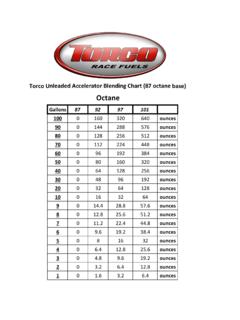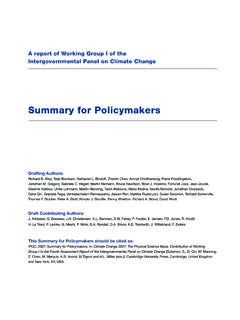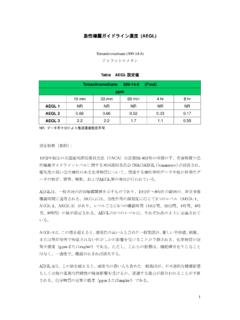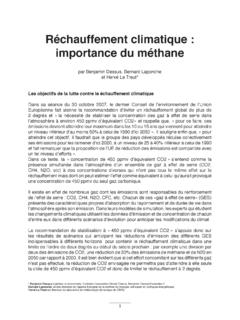Transcription of SAFETY DATA SHEET - Torco Race Fuels
1 Nitromethane Product Part Number: 31101. MSDS Date: April 19, 2015. SAFETY data SHEET . Health & SAFETY Information Section 1: Identification of the substance/mixture and of the company Product identifier Nitromethane Product Code 31101. Relevant identified uses of the substance or mixture and uses advised against Intended use See Technical data SHEET Details of the supplier of the SAFETY data SHEET Company name Torco Race Fuels 2527 W Dallas Ave. Apache Junction, AZ 85120. Telephone No. (480) 288-9385. Emergency telephone number (800) 424-9300 24 hr.
2 Section 2: Hazards Identification Classification of the substance or mixture Not Classified Label elements Using the Toxicity Date listed in section 11 & 12 the product is labeled as follows: Not Classified HMIS Health: 1 NFPA Health: 1. Fire: 3 Fire: 3. Physical Hazards: 0 Reactivity: 4. PPE: C Special Hazards: --- Other hazards None Section 3: Composition / Information on Ingredients Ingredient/Chemical Designations CAS Number Weight % EC No. 1272/2008 /. GHS Classification Nitromethane 75-52-5 > Not Classified *The full texts of the phrases are shown in Section 16.
3 Section 4: First Aid Measures Description of first aid measures: General In all cases of doubt, or when systems persist, seek medical attention. Never give anything by mouth to an unconscious person. Inhalation Remove person to fresh air and keep comfortable for breathing. If not breathing, give artificial respiration. If breathing is difficult, give oxygen. Get medical attention immediately. Skin If on skin (or hair): take off immediately all contaminated clothing. Rinse skin with water/shower. Constant contact can lead to defatting and drying of the skin.
4 If skin irritation occurs: get medical advice/attention. Eye Rinse cautiously with water for several minutes. If eye irritation persists: get medical advice/attention. Ingestion If swallowed: immediately call a poison center/doctor/ physician. Do not induce vomiting. If ingestion has occurred within one hour, protect the airway and perform gastric lavage followed by the administration of activated charcoal. If greater than one hour since ingestion, protect the airway as needed and administer activated charcoal. Most important symptoms and effects, both acute and delayed Exposure Health Effects Symptoms of Exposure Route Inhalation: Effects on the Central Nervous From rapid breathing, fatigue, headache, light- system (CNS) may range from headedness to more severe symptoms of dizziness and mild to severe effects such as in extreme cases, respiratory arrest, convulsions or loss respiratory depression.
5 Of consciousness. Ingestion: May be aspirated into lungs if Signs and symptoms of aspiration may include swallowed, may result in coughing, difficulty breathing, gurgling lung sounds pulmonary edema & chemical when breathing, coughing up phlegm (sputum) that is pneumonitis. yellow or green in color or bad smelling, change in voice (hoarseness), skin turning bluish due to lack of oxygen. Section 5: Fire Fighting Measures Extinguishing media Small Fire: dry chemical, CO2, or fire-fighting foam. Large Fire: fire-fighting foam. Fire-fighting foams which can be used are as follows: Fluor protein (FP)- Aspirated, Film-Forming Fluor protein (FFFP)- Non aspirated or aspirated, Alcohol- Resistant FFFP- Non aspirated or aspirated, AFFF - Non-aspirated or aspirated, AR- AFFF - Non- aspirated or aspirated.
6 Special hazards arising from the substance or mixture The highly flammable vapors are heavier than air and may accumulate in low areas and /or spread along ground to distant ignition sources and flash back. Thermal decomposition produces acrid fumes. Vapor-air mixtures are explosive above the flash point. Advice for fire fighters If tank, rail car or tank truck is involved in a fire, isolate for 800 meters (1/2 mile) in all directions; also consider initial evacuation for 800 meters (1/2 mile) in all directions. Move container from fire area if you can do it without risk.
7 Apply cooling water to sides of containers that are exposed to flames until well after fire is out. Stay away from ends of tanks. Stay away from tanks engulfed in fire. Closed containers exposed to heat may explode. (OSHA Class 1B Flammable Liquid). Withdraw immediately in case of rising sound from venting SAFETY device or any discoloration of tank due to fire. Cool fire-exposed containers with flooding quantities of water applied from as far a distance as possible. Section 6: Accidental Release Measures See Guide Emergency Response Guidebook (Trans.)
8 Can/US Dept. of Trans). Personal precautions, protective equipment and emergency procedures Precautions: This highly flammable liquid must be kept from sparks, open flame, hot surfaces, and all sources of ignition and heat. The highly flammable vapors are heavier than air and may accumulate in low areas and /or spread along ground to distant ignition sources and flash back. Protective Equipment: Gloves: Recommended: neoprene and nitrile. Not recommended for heavy use: rubber, PVC, latex. Respirator: NIOSH Approved and equipped with organic-vapor filter.
9 Eye: SAFETY glasses with side shields, SAFETY goggles or face shields. Clothing: Flame-retardant Nomex, Proban. Emergency Procedures: Shut off leak/release source, if it can be done safely. Remove all sources of ignition. Isolate hazard area. Evacuate area of all unnecessary personnel. Keep unnecessary and unprotected personnel from entering. Emergency personnel must wear appropriate personal protective equipment. Environmental precautions Prevent entry into sewers and waterways. Report spills as required to appropriate authorities in accordance with all applicable regulations.
10 Very toxic to aquatic organisms. May cause long-term adverse effects in the aquatic environment. Methods and material for containment and cleaning up Use non-sparking tools and equipment. Use booms/pillows to prevent runoff into storm sewers and ditches that lead to waterways. Have foam or dry powder extinguisher on hand. Contain and recover liquid if it can be done safely: Collect spillage or absorb with an inert material ( , vermiculite, dry sand, earth), and place in metal container which can be grounded. Do not use combustible materials, such as sawdust, as absorbent.






